How to facilitate scenario planning workshops
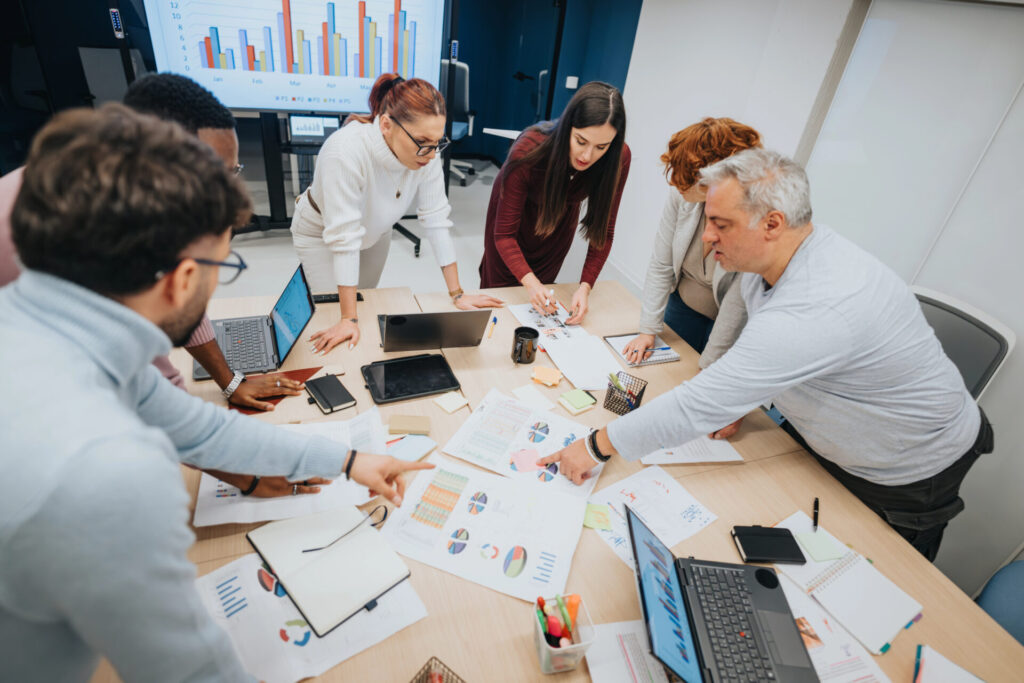
The future isn’t something we predict. It’s something we explore.
In these complex, uncertain, and frankly scary times, facilitators are increasingly being asked to help teams think long-term, make sense of the uncertainty, and plan for the unknown. Whether you’re guiding a group through climate resilience strategies, preparing a nonprofit for demographic shifts, or helping a company imagine the impact of AI, future scenario planning can be a powerful tool for navigating future challenges.
This article is a practical introduction to how to run a scenario planning process. We’ll look at what futures thinking actually means (no crystal balls here), how scenario planning works, and why it’s so valuable for facilitators and teams. You’ll also find example use cases, other facilitation methods for working with futures, and a full workshop structure you can adapt to your needs.
For more methods and inspiration, download SessionLab’s Facilitating Futures playbook, created in collaboration with futurist Suzanne Whitby of Futures Fit. It’s packed with 15 practical techniques, facilitation tips, and real-world stories to support your work.
What is futures and foresight?
Futures thinking is a structured approach to imagining what might happen, why it could happen, and what we can do about it. It invites us to explore future conditions and the driving forces shaping tomorrow’s world.
Foresight is the practice of using specific tools and methods to support that process, such as horizon scanning, market trend analysis, or scenario planning. While the terms are sometimes used interchangeably, futures is the broader mindset, and foresight is the toolbox.
Futures work is about discussing possible, plausible futures: spotting early signals of change, considering critical uncertainties, and helping groups navigate complexity with clarity and imagination.
Whenever life becomes more hectic and uncertain, scenario planning becomes more popular.
Kees van der Heijden, author of The Sixth Sense – Accelerating Organizational Learning with Scenarios
What is scenario planning?
Scenario planning is a structured method for developing multiple scenarios. Scenarios, in this context, are plausible versions of the future, designed with the purpose of helping people, and teams, make better decisions in the present.
Instead of aiming for a single forecast, scenario planning helps teams explore a range of different future outcomes, generally based on uncertainties like regulation, interest rates, emerging technologies, climate impact, or cultural shifts. You can think of each scenario as a story, a narrative that reflects different variables and strategic possibilities.
This process is especially useful in strategic planning, innovation, risk management, and operational scenarios. The task of creating plausible narratives together, in teams or multidisciplinary groups, leads to deeper understanding among participants. As is often the case with facilitated workshops, the journey (process) is what really counts, more than the destination (outcome).
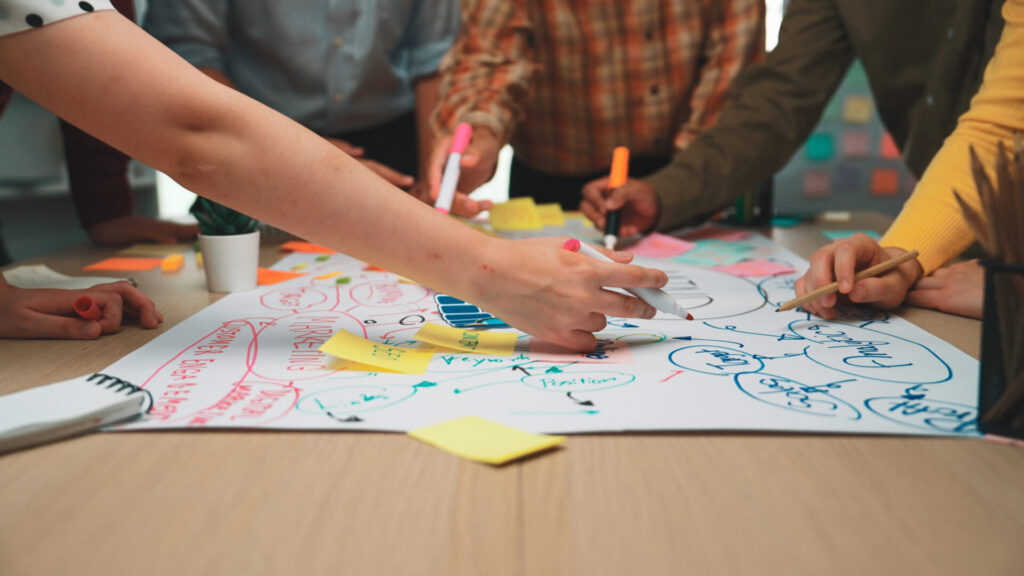
How facilitators can benefit from futures work
For a long time, I relied on just two tools when helping groups think about the future: backcasting and guided visualisation.
Guided visualisation is something I’ve used to open the door to imagination and hope. It is about guiding participants into a relaxed state and inviting them to time travel to a future world where things turned out ok (whatever that means for them).
After sharing what those imagined futures have in common, I’ve often used backcasting to encourage participants to define the practical steps to get there. These tools have helped me guide people in accessing both the practical and emotional layers of change.
I’ve used these techniques with everyone from university students to community leaders, mostly in the context of climate change and social justice work. I’ve been struck often by how powerful they can be, and how coherent our visions of the future often are.
The level of technology present in these future scenarios varied, but there was reliably more greenery. Cleaner air, quiet, and birdsong were frequent answers to my question What is the first thing you notice, what tells you that you are in a different world from today’s? These insights told the group something about what people truly value.
For years, these two tools were enough. But after joining the International Association of Facilitators’ SIG (Special Interest Group) on Futures, I’ve been amazed to learn just how many methodologies facilitators can use to help groups navigate rapidly changing environments.
In a world that’s changing rapidly, we need more than goals and plans. We need futures literacy: the capacity to think ahead, imagine alternatives, and act with intention.
5 ways futures work supports facilitators and their groups
- Brings clarity to uncertainty
Futures methods help make sense of key drivers and emerging trends. You won’t predict the future, but you’ll be better equipped to face it. - Expands imagination and creativity
We often plan based on what we already know. Futures work invites play, narrative, and curiosity. - Surfaces assumptions and values
Scenario planning and speculative tools help people uncover what they believe, fear, or desire, helping to bring hidden perspectives into the open. Ultimately, this can lead to better decision making. - Supports resilience and readiness
Exploring multiple scenarios allows teams to stress-test ideas, challenge blind spots, and prepare for unexpected events. - Strengthens group alignment
A shared look at the future environment brings people together and supports more purposeful, values-driven strategic thinking.
One thing I notice is that often participants are rebuilding atrophied muscles of deciding what they want. We give up the power to design futures before we even know we’ve done it. Unlearning that habit, and asking hard questions often is frictionful but fruitful!
Ben Mosior, Leadership Development & Strategy Consultant, co-author of the Strategy Tactics Pip Deck
Real-world examples of future scenario planning in action
Facilitators are already using futures thinking in a wide range of contexts, from corporate strategy to environmental justice. Here are three examples from the Facilitating Futures playbook that show what this work can look like in practice.
Lighting the way: immersive futures for strategic change
Corporate foresight and participatory workshops
Suzanne Whitby, foresight facilitator and founder of Futures Fit, was invited to work with a European lighting company ready to move from reactive to proactive strategy. This is how she describes the reason her team was called in: “Their challenge: they were tired of being reactive. Their new generation of leaders were keen to embrace sustainability as a real strategic lever. They wanted to start shaping the future of their industry.”
The team co-created four future scenarios and guided every employee, from engineers to the C-suite, through participatory workshops. “Using the scenarios as provocations, teams explored how they might respond. Conversations were open, critical, and hopeful.”
Insights were harvested and turned into visual posters for all company sites. Leadership used this input to develop strategic pathways.
Real futures thinking isn’t just top-down. It lives in the everyday imagination of the whole organization.
Suzanne Whitby, founder of Futures Fit
Just energy transitions and collective sense-making
Multistakeholder facilitation in Brazil
Christel Scholten, managing director at Reos Partners Brazil, has used scenario processes for over a decade, focusing on justice, systems change, and inclusion.
In one case, her team facilitated a scenario project on Brazil’s just energy transition in 2040. It involved 30–45 participants over several in-person workshops, grounded in systems mapping and collective sense-making.
In Christel’s words: “We often facilitated a collective systems mapping exercise of the current state of the system… They would write these on hexagon sticky notes which we clustered on the wall. The next day these would be used as input to define the key uncertainties.”
Importantly, her team ensured inclusion of diverse perspectives:
Each scenarios process I facilitated involved Indigenous and Black people in the scenario team to integrate the diverse voices of the Brazilian population.
Christel Scholten, managing director at Reos Partners Brazil
Exploring the future of AI in facilitation
Workshop facilitation at a professional gathering
At the annual Facilita conference in Milan, Sara Tremi Proietti and Barbara Bellucci co-led a workshop asking how AI might reshape the future of facilitation.
Using the Futures Wheel method, they guided small groups through reflection, scenario building, and used live AI interaction via WhatsApp prompts they had pre-prepared for participants to use.
I was actually in one of those groups and really enjoyed how the structured approach guided our small group of five facilitators into sharing and discussing different visions of the future. There was room for utopia and dystopia, for airing hopes and fears as well as data-driven realism. Ultimately, those varied perspectives came together into a shortlist of possible directions, as well as initial ideas on how to future-proof our businesses.
Our goal was to guide participants into the future through small-group discussions and hands-on experimentation with AI… to explore potential blind spots in their thinking.
Sara Tremi Proietti, International Association of Facilitators, Italy chapter co-chair
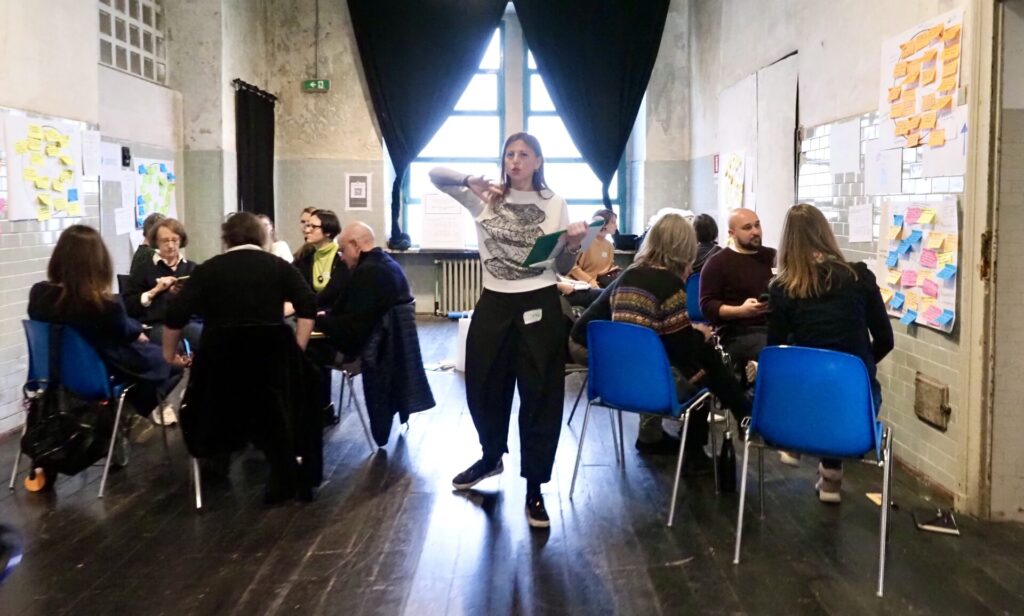
Futures methods to try in your next workshop
You don’t need to be a foresight expert to guide meaningful futures conversations. With the right structure and a few adaptable methods, facilitators can help teams open up their thinking, explore change, and plan for what’s next.
Here are five versatile methods you can start using today, each linked to a different stage of a future scenario planning workshop.
To guide participants through a futures process, it helps to have a clear structure. The Facilitating Futures framework breaks a workshop into six distinct stages: Opening, Mapping, Anticipating, Envisioning, Embodying, and Acting.
This flow mirrors how many groups naturally explore complex issues. You begin by opening the space and shifting into a more expansive mindset. Then, you map the present to understand the forces already in motion. Anticipating helps participants explore what could happen next, while envisioning builds fuller pictures of different possible futures. Embodying brings these futures to life, not just as abstract ideas, but as something participants can feel, design, or express. Finally, in acting, the group returns to the present, identifying strategies and next steps with clarity and purpose.
It’s not a rigid sequence, but it’s a helpful arc for designing workshops that move from imagination to insight to action.
A note of caution: tools alone won’t make you a skilled facilitator of futures conversations. Futures thinking is a well-established discipline with roots in academia, and we strongly recommend getting to know its core concepts and ethics before jumping in. Sharing just a little of that background with your participants can go a long way too; it helps avoid the common traps of drifting into fantasy, fear, or vagueness that lead nowhere.
Opening: Headlines from the Future
Headlines for the future is playful way to begin. Ask participants to imagine a future event or breakthrough, and then write a newspaper headline about it. This activity sparks creative thinking, surfaces hidden hopes or concerns, and sets a tone of exploration.
Use this early in your session to warm up the group and introduce the idea that multiple futures are possible. I’ve used it in workshops with local citizens to raise motivation around environmental conservation: will future headlines hail our good work, or condemn us for inaction?
Mapping: Future Trends
Once your group is thinking more broadly, it’s time to map the present. This method invites participants to brainstorm the trends shaping their industry or context across categories like technology, behaviour, business, or policy.
After identifying and prioritising trends, participants explore what opportunities or risks they might bring. This step creates a grounded foundation for imagining what could come next.
Anticipating: The Thing from the Future
This speculative game asks participants to imagine an object, service, or artefact from a future world. It’s simple, surprising, and works particularly well to stretch the imagination and loosen assumptions.
You can use this method to expand a group’s sense of possibility before moving into more structured scenario building.
Envisioning: Scenario Planning
The heart of many futures workshops, this method helps participants explore different plausible futures by creating a set of distinct scenarios. Typically, the group starts with two uncertainties (such as “policy: restrictive or supportive” and “tech adoption: fast or slow”) and maps them onto a 2×2 grid.
From there, small groups develop scenario narratives for each future quadrant. What’s happening in this future world? Who is affected? What does it mean for our strategy?
The scenario development process is an excellent tool to expand awareness and prepare for complexity.
Acting: Risks, Opportunities and Resilience
Virtually every futurist I’ve spoken to has offered some version of the following advice: never let a group leave a futures workshop without some action planning. Futures scenario design and all the other futures and foresight activities we’ve been looking it ultimately lead into making changes in the present. Therefore, it’s important to include an action-planning activity at the end, or risk leaving participants with a feeling of futility.
There are many action planning methods you might use, including Backcasting or, for a fun twist, Triz (a Liberating Structure in which you’ll be asking people to brainstorm actions they might take to obtain the opposite outcome to the one they desire).
If the group has identified a scenario they aspire to contribute to realizing, Risks, Opportunites and Resilience is a great method to apply.
In small groups, ask participants to discuss and record:
- Risks: What could go wrong? What might be disrupted, lost, or destabilised?
- Opportunities: What new possibilities might open up? Who could benefit?
- Resilience: How well prepared are we? What capabilities, resources, or relationships would help us respond or adapt?
This method works well at the end of a futures process, as a bridge into strategic planning. It supports balanced, practical conversations that go beyond excitement or fear, focusing instead on preparation and adaptability.
You can find these and many other methods in SessionLab’s Library. Just look for the keyword “Future”.
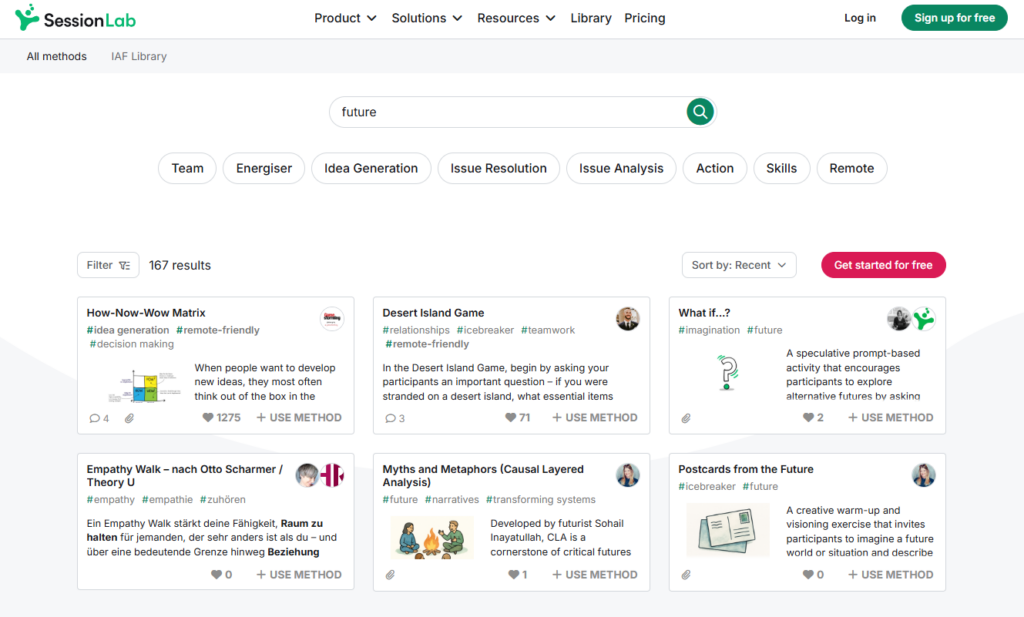
Scenario planning: a closer look
Among the many tools in the futures facilitator’s toolkit, scenario planning stands out as one of the most structured and widely used. It has a long history, first formalised at the RAND Corporation in the 1950s and later popularised by Royal Dutch Shell in the 1970s, where it helped the company anticipate and respond to the 1973 oil crisis. Since then, it’s been used by governments, businesses, nonprofits, and communities to build strategic capacity in times of uncertainty.
Rather than trying to predict the future, scenario planning explores what might happen if key uncertainties unfold in different directions. The typical approach involves identifying two critical variables (such as “regulation: tight or loose” and “tech adoption: fast or slow”) and using them to create a 2×2 matrix. Each quadrant becomes a distinct scenario: a plausible world with its own risks, opportunities, and dynamics.
Scenario planning is especially valuable when working with finance teams, corporate strategists, or communities tackling future growth and uncertainty. It’s a method that connects historical data and expert knowledge with structured imagination.

This method invites groups to:
- Engage deeply with uncertainty
- Stretch their thinking beyond business-as-usual
- See challenges and opportunities in new ways
- Uncover shared values and assumptions
- Prepare for a range of futures, not just one forecast
Scenarios are useful when they meet four criteria: they must be relevant, illuminating current circumstances and concerns, and connected to current thinking; challenging, making important dynamics that are invisible visible and raising questions about current thinking; plausible, logical and fact-based; and clear, accessible, memorable, and distinct from one another.
Adam Kahane, from his book Trasformative Scenario Planning – Working Together to Change the Future.
Once participants have imagined these worlds, they reflect on what each scenario would require. What new capabilities would they need? What strategies would still make sense? Where do their current assumptions hold up—and where might they fail?
Scenario planning can stand alone or form the centrepiece of a longer workshop, as we’ll see below.
From methods to flow: how to design a futures workshop
I often point out that workshops aren’t just an assembly of random methods. The real value lies in the flow: how one activity sets up the next, and how the whole session builds toward reflection, insight, and action.
This is especially true when working with uncertainty. Futures methods are powerful, but only when they’re placed with intention. If you’re wondering how to weave multiple futures tools into a coherent session, and what that might look like, check out this
Futures Workshop Template.
The template guides a group through a complete futures conversation, moving from warm-up to mapping trends, building scenarios, and planning action. It includes methods including Postcards from the Future, Futures Triangle, Scenario Planning, and Backcasting, all timed and sequenced in a practical agenda you can adapt to your own context.
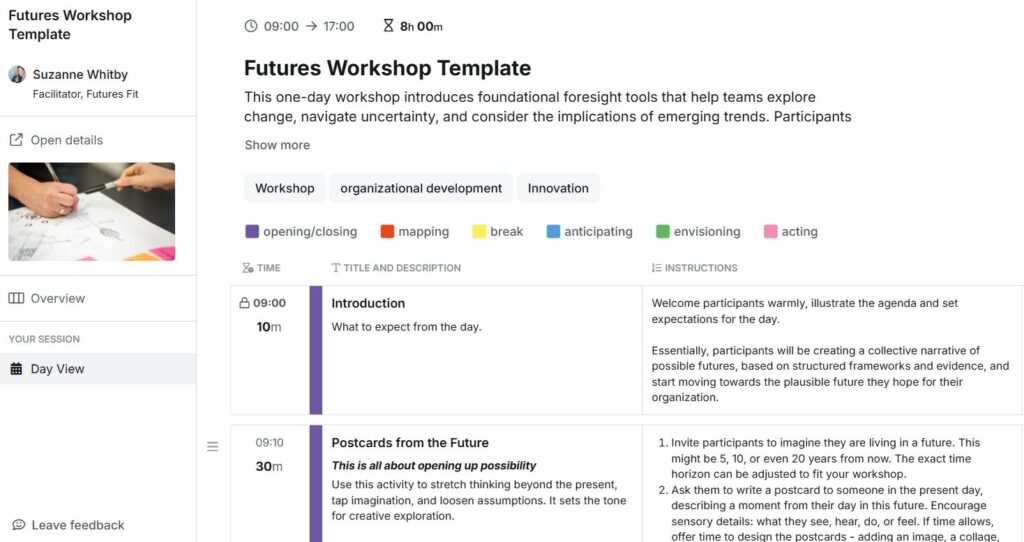
Designing a scenario planning exercise doesn’t need to be overwhelming. With a collaborative approach, clear purpose, and practical tools, you can guide groups toward alignment and actionable outcomes. Using SessionLab can help by providing a simple scaffolding for selecting and arranging methods that supports creativity as well as avoiding having to start from scratch. We’ve recently added many futures-focused tools to the SessionLab method library, so you’ll find plenty to work with, whether you’re running a strategic foresight session, a creative exploration, or something in between.
5 tips for facilitating futures workshops
Futures methods are great, but they don’t run themselves. How you guide the process makes all the difference. Working with uncertainty, multiple perspectives, and long time horizons can surface hope, discomfort, even grief. It can also unlock imagination and bring people into deeper alignment.
Here are a few principles and tips to help you facilitate futures workshops with care and clarity, based on practical experience shared in the Facilitating Futures playbook.
1. Do your research
Doing some research about the group you are going to be working with is due diligence and common sense. Don’t push a timid group of new staffers to embody a utopian future, theatricals and all, in front of their boss.
Conversely, quiet, focused writing on sticky notes might not be the thing for energetic NGO volunteers. Interviews with your clients and, ideally, a few participants, will inform your thinking and enable you to create the right program for that specific group.
2. Stress that this is about action, not prediction
The idea that futures thinking is akin to having a magic ball or doing some sort of astrology is where most of the resistance to this work stems from. Clarify that we work with the future to build capacity in the present, and keep it practical.
Use concrete prompts, sensory language, and examples. Encourage groups to describe what people see, feel, say, or do in a future scenario. This helps shift conversations from abstract ideas to something more embodied and relatable.
3. Leverage diversity of opinions
Challenge the group if their views are too hopeful or too bleak. Futures work is at its most valuable when it skirts speculative fiction yet stays close to possibilities and realities. Full-fledged utopias and dystopias might be useful thought experiments, but for influencing our groups and organizations, it’s more useful to remember that all plausible futures will always be a mix of good and bad. Encourage the group to look at different possible angles.
4. Give it space
Some people readily jump into using their imagination but that is not all people. Rushing into these activities is likely to make your futures flat, unimaginative and yield little that is of use. Ease the group into these activities. The opening activities will help with this, as will some good examples: think of those ahead of time.
Imagination is like a muscle, it needs to be used. While participants found it strange to imagine positive futures by the third month we were reaching over 100 years into the future and found lots to celebrate.
Sophia Cheng, founder of With Many Roots
5. Always include action planning
Even when the focus is long-term, always return to the present. What insights will shape today’s decisions? What small steps can move us toward a better future? The real power of futures work lies not in prediction, but in preparation.
Don’t leave the group hanging and wondering: “so what was that for?” If you don’t have time for a longer closing activity, at least host a round of “What is one thing you’ll do/change as a consequence of this exercise?”
Want to go deeper?
Here are some well-regarded resources on the history and practice of scenario planning:
- Book: Transformative Scenario Planning by Adam Kahane
An inspiring introduction to how scenario planning can be used for large, whole-system work. - Book: The Art of the Long View: Planning for the Future in an Uncertain World by Peter Schwarz.
A business-oriented classic on scenario planning and its strategic use. - Website: Institute for the Future
Workshops, training and lots of resources for deep dives into futures and foresight. - Toolkit: Facilitating Futures
Whether you’re running your first scenario planning workshop or expanding your future practice, having the right tools makes a difference. The Facilitating Futures playbook is designed to support you with practical methods, case studies, and real-world tips to use in any setting.
Download your free copy and start shaping more thoughtful, courageous, and forward-looking conversations.
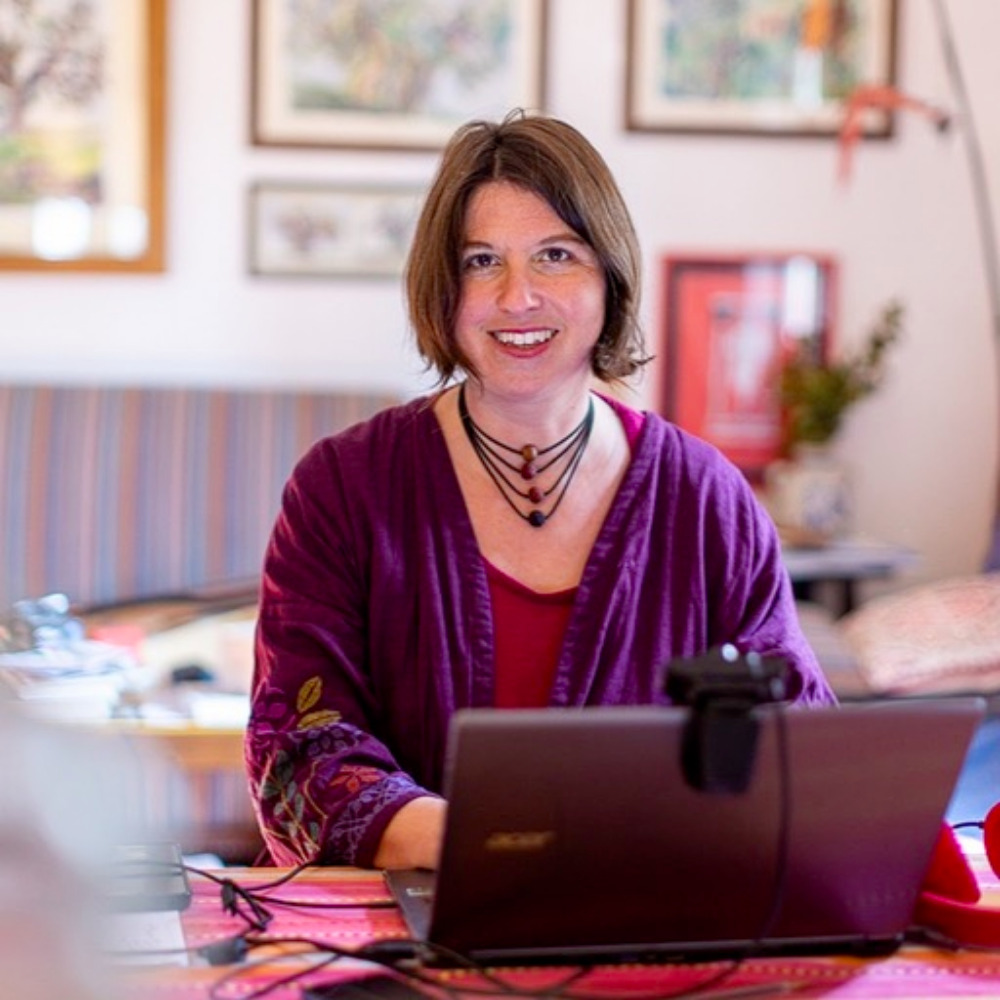
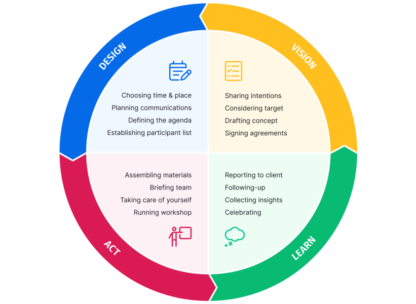
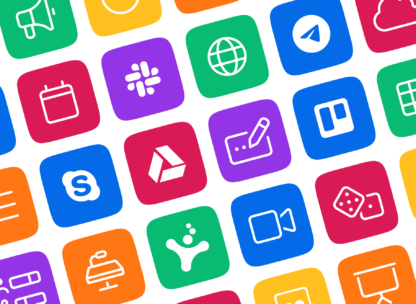
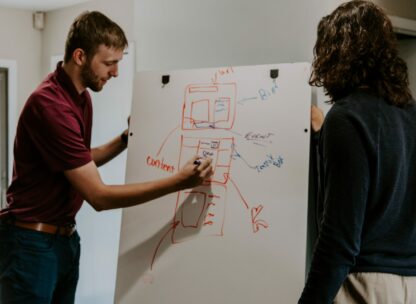
Leave a Comment